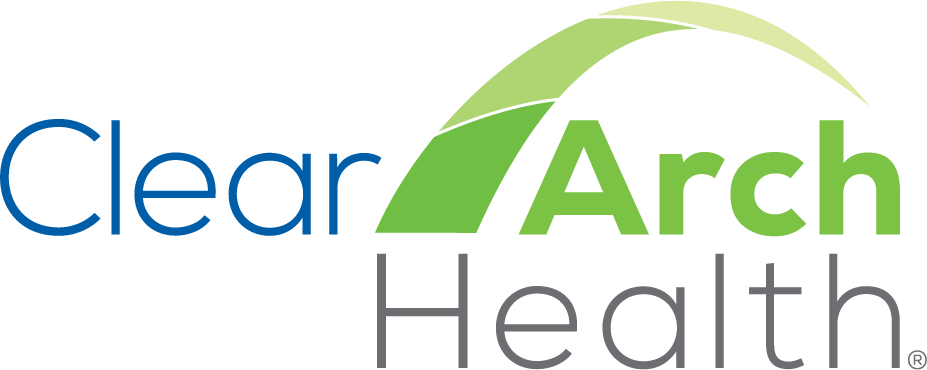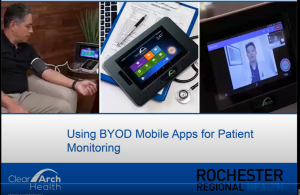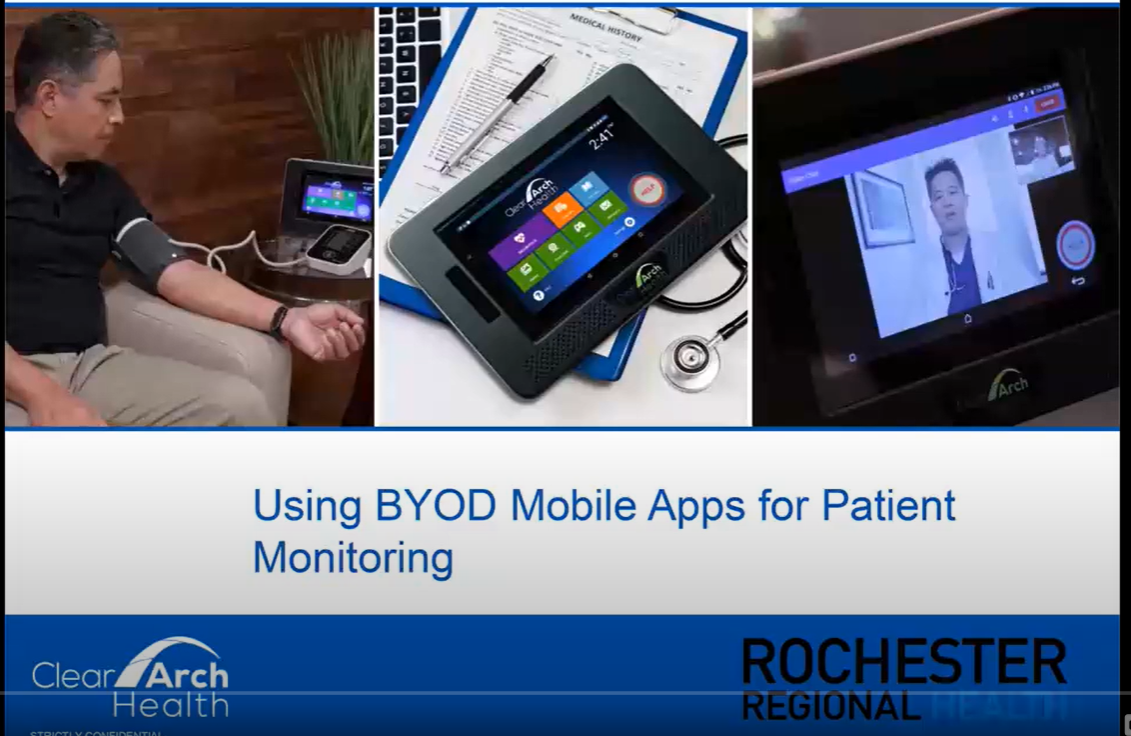This Clear Arch Health podcast episode features American Telemedicine Association (ATA) leadership (Ann Mond Johnson, CEO and Kyle Zebley, Sr. VP of Public Policy) talking about telehealth, the end of the Public Health Emergency, and virtual care going forward.
Listen and read the full text here below!
Introduction:
Welcome to Transforming Healthcare with Clear Arch Health, an ongoing conversation about developments shaping digital healthcare.
Clear Arch Health is a leading provider of advanced remote patient monitoring technology, personal emergency response systems and turnkey virtual care solutions.
In this podcast episode, we’ll hear from Ann Mond Johnson, CEO of the American Telemedicine Association, and Kyle Zebley (American Telemedicine Association Senior Vice President of Public Policy), in a timely discussion surrounding the May 11, 2023 expiration of the Public Health Emergency.
Joined by Bill Paschall, Senior Vice President of Growth and Strategic Accounts for Clear Arch Health, today’s guests will help us to better understand how this may influence telehealth policy, flexibilities and patient access to quality remote-based healthcare.
Let’s listen in to learn what we can all do to ensure telehealth remains available to all patient populations, wherever and whenever they need it.
Bill Paschall:
Hello, everyone. I’m Bill Paschall, and today we’re going to discuss the end of the COVID Public Health Emergency and what does this mean for telehealth.
I’m very excited today that we have Ann Mond Johnson, current CEO of American Telemedicine Association, here today along with Kyle Zebley, who is really the policy guru, man of the hour, in many aspects.
Thrilled to have both of them here today.
Ann, you’ve had a pretty exceptional career and then taking the helm of ATA as CEO in 2018. Really the organization had not hit its stride with telehealth advocacy — and you’ve just been pushing us into becoming an exceptional (and the only) organization currently 100% focused on telehealth adoption and advocacy; added ATA Action and brought on talent like Kyle, who we’re glad to have here today.
What else is on the horizon for ATA?
Ann Mond Johnson:
Well, that’s a great question, Bill, and thank you very much for having both of us.
It’s fun to be on with you as well as with Kyle.
The future is really terrific for us because from a policy perspective — and I’ll let Kyle address this in greater detail — there is no better bipartisan issue right now than telehealth. And, so, we’re excited about that.
The second is that prior to the pandemic in 2020, we were battling a lot of myths about what telehealth was and wasn’t. And, what we found in the last three years, 3 plus years now, is that telehealth is extraordinarily effective both from a patient and a provider’s perspective.
And so, we feel that the past 3 plus years have shown that there is no real decline in quality; that it’s very consistent with what you would see in person, as well as it’s been very cost effective beyond just the whole issue of people taking time away from work to get to the doctor’s office.
So, the problems that we had pre-pandemic with an insufficient number of clinicians to deal with our aging population, our growing elderly population, and sick quite frankly, has really been addressed very effectively during the pandemic.
Obviously, we have some things we still have to take care of in terms of disparities, and I can talk about that later, if it’s of interest.
Paschall:
Thanks, Ann. So, the Public Health Emergency official end is May 11th.
There are some things that take effect immediately, some things that have been pushed off until December 31st, 2024.
For American Telemedicine Association, in general, and the things that you’ve just described, how do you think the end of the PHE affects the American Telemedicine Association’s mission?
A.M. Johnson:
Sure, and again prior to the pandemic, we have policy principles that inform our advocacy work and policy work, and those include the fact that we’re venue, and modality, and device agnostic.
So, what happened during the Public Health Emergency and with all the waivers that were in place that Americans across the board saw that we could really deliver on the promise of digitally enabled care and services.
And so, we are really advocating hard, and again I’ll let Kyle jump in and discuss this in greater detail, the waivers become permanent. And again, it’s really allowing regulation and legislation to catch up with what technology has been able to deliver for quite some time.
Kyle, what would you add to that?
Kyle Zebley:
No, Ann, I think you’re spot on. For the ATA, from the moment that the flexibilities came about because of the work that we did, working with the last administration to make these flexibilities happen. We have been working to make sure that they’re on the road to permanency.
One of the things that we were successful in doing, at the end of last year, was pass a very broad funding measure that passed with Mike [ unclear ]’s work that included a number of favorable telehealth provisions that, Bill, as you mentioned, will mean that these, many of these possibilities will be in place and available to the American people, until the end of 2024.
I think that we’re on the road to permanency for all those measures in terms of lifting the geographic and originating site restrictions, and [unclear] law, and making sure that federally qualified health centers, rural health clinics are able to cover and get reimbursed for telehealth services.
These things are, I think, on the road to permanency.
We’re obviously monitoring very closely the potential ripple effects of what will happen come the end of the Public Health Emergency for those items left out.
For instance, issues of whether or not — and for the length of time that telehealth will be reimbursed at a higher level — issues of reinstatement of copays that you know well in terms of remote monitoring; issues of what the reinstatement of the HIPAA flexibilities will look like as we get that sense of an off ramp.
So, other issues that we’re definitely monitoring, but we’re very pleased with the huge advancements we’ve made and the fact that we’re on the road to seeing a lot of these favorable conditions permanently embedded in law.
Paschall:
Thanks, Kyle, and Anne, for that.
Let’s talk about something that’s specific and we’ve seen recently a lot in the headlines around this, and that’s the Ryan Haight Act around e-prescribing and the changes that look like might be coming with that.
Kyle, what do you think is going to happen in the short term and in the long term there?
Zebley:
So, we’re speaking to you today on May 8th and of course, the Public Health Emergency is set to end on May 11th.
The DEA had the responsibility of coming up with what the rules of the road for remote prescribing of controlled substances would be, post the end of the Public Health Emergency, in just a few days’ time.
We think that it was despite the fact that it had 15 years to implement a process for remote prescribing controlled substances, we think that they ended up coming up with very rushed proposals; proposals that we believe would have taken us backwards.
We’ve had a status quo over the last three years during the Public Health Emergency that has enabled remote prescription of controlled substances and we think that in some way, shape or form, the DEA should continue to allow for that access. Unfortunately, we’re in a position now where the DEA’s gonna have to make some very hard choices.
We know that they’re asking the Biden administration, and the White House, for an extension of the waiver, post the end of the PHE, and, yet– again this is very much a question of when listeners will be hearing this –as of right now, we do not know for the length of what that time might be for the extension, or how much it mirrors current flexibilities.
But our hope is that they’ll take the time of an extension, the DEA, to get these rules right to make sure that they keep accessibility to appropriate care Top of Mind.
Paschall:
Thanks, Kyle. That’s a good insight.
And the end of the PHE we talked, you talked, about some of the things that happened immediately: reinstatement of copay, for example, on remote patient monitoring for that 20% that the patient is responsible for.
So, the impact of the ending of the Public Health Emergency on remote care, home care, post-acute care, transitional care, really, many of the areas in telehealth — do you think before the end of 2024… which is… now there’s an extension through the Omnibus Act that you mentioned, that there will be permanent legislation, and is anything specific underway now that we can support?
Zebley:
So, a really important item that was included in that Omnibus Funding Bill was extended till the end of 2024, the Acute Hospital Care-at-Home Program (that we’ve been very supportive of) that’s really at the cutting edge of getting patients out of hospitals while they’re still convalescent. I think there’s a huge potential there and we were very glad to see that it was extended.
I think that one of the great benefits of how remote monitoring has been treated by Centers for Medicare and Medicaid Services through, for instance, Medicare Part B
Fee-for-Service, is that it’s never had the restrictions that synchronous telehealth has had. So there have not been the geographic and originating site restrictions. That’s really favorable.
And, so, a lot of the advancements that we’ve had outside the Public Health Emergency have been through the usual ‘annual rule making process’ that’s allowed for first, remote physiologic monitoring, and now, also remote therapeutic monitoring to be covered by the Medicare program.
But to your point, whether it’s issues of copay or whether it’s issues of clinically inappropriate restrictions to telehealth, there are a number of areas where we think that it might well be possible for the Congress to weigh in, and kind of nudge CMS in the right direction to more robustly cover and reimburse for telehealth services — like remote monitoring care — than they’re currently doing.
So, I do think that there is possibility for increased legislative interest in this area.
Paschall:
Ann, earlier you talked about health equity, and said we could come back around to that. I think I’d like to do that now.
Several of the areas that we’ve seen a lot of activity in legislation recently have been around behavioral health and maternity, in funding and other acts.
So, tell me how ATA is involved, and how ATA members can help/be involved in promoting Health Equity.
A.M. Johnson:
Absolutely. And, so just to touch on behavioral health for a minute, we know that even pre-pandemic, with guidelines that the ATA co-published with the American Psychiatric Association, the headline was essentially that virtual is as good as, if not better than, in person for video synchronous care, and so those guidelines we updated with the benefit of the experiences associated with the pandemic.
We still think that behavioral health has been a huge, huge boon to the 1 in 5 Americans right now who have some mental health issue they’re dealing with.
As it relates to equity, we in 2020 organized an advisory group on using telehealth to eliminate disparities associated with healthcare, and recognizing that what we’re contending with, as a society, is a real restructuring, or reimagining of how care is delivered, and you cannot do that if you don’t use technology.
And so, the advisory group, the first output of what they did was create a framework, and it’s really a pyramid that identifies levers that can be used as we think about how to eliminate disparities.
And at the top of that pyramid is connectivity. And the reason for that is that there’s a lot of attention and discussion about broadband and it’s clearly an issue in many parts of the country, rural, in fact, even in some parts of urban communities.
But what we also wanted to acknowledge that was that that was the most visible issue that needed to be addressed and that beyond that you had issues of affordability,
of data plans, accessibility, issues of literacy, both digital as well as health literacy.
If people could access it, and they had the device to access, did they even understand how to use it?, (whatever it was) as an application …
And, then issues of trust, which is another area that we’re still contending with in an environment where there’s eroding trust across the board. Not just in healthcare, but across the board.
So, our hope is with the work that we’re doing on disparities is to create a heat map that will allow people to understand what investments are required to improve digital infrastructure, and then on that, what is the economic value added to a community if that digital infrastructure is improved, and if programs are put in place to address folks and communities that have just not had access to the care they’ve needed consistently.
Paschall:
Thanks, Ann.
You touched on something there, and now I just wanna go a little bit deeper and that was the value of care in the community.
So, if we look at big trends, one of the things we’ve seen telehealth is a lot of innovation, a lot of things happening in there, a lot of small companies, a lot of startups, some of them growing into unicorns in the space.
But we’re seeing a tightening of equity now. So, do you think there will be a shift that more funding to improve health equity will come from the government, as opposed to private equity helping fund startups, that it can have an impact in that space?
A.M. Johnson:
I think you’re seeing it across the board, Bill. I mean, certainly there’s legislation that has gotten a lot of attention, even some success as it relates to maternal health, where we’ve had rotten, rotten statistics and data that point to real discrepancies between communities of color and white women in terms of their maternal health and outcomes.
But beyond that, I think what’s very exciting is some of the socially focused organizations, and you know, the [B Corps] that are emerging as well. So, I don’t think it’s all on the government.
I think what has come out of the last couple of years is this idea that, if we’re going to fix a global problem, we have to really all join in and not rely on one particular part of the community to step up and resolve issues.
Zebley:
And, Bill, if I could just briefly add something on top of what Ann said.
She had referenced earlier the ATA’s policy principles that have been developed closely with our members and members of our ATA Policy Council. And, one of those principles, of course, is to make sure that we’re keeping underserved communities that have been left behind by the healthcare system in mind when we go out and advocate for good public policy. And so, obviously there’s a huge role for the private sector to play here.
But as we also think about our advocacy and our conversations with our bipartisan supporters, both in Congress at the federal level and also at the state level. There’s no work that we do at the ATA and the ATA Action that doesn’t view each of these various pieces of legislation or various regulations through that prism. By supporting or opposing a particular measure, are we furthering that aim? And, so, it’s something that’s extraordinarily central to our mission.
It’s something that starts with Ann’s leadership in the board and then trickles down to every aspect of the work that we do. And so, I just wanted to really underline and emphasize the points that Ann was making on that … it’s one of the biggest you know, really calls to action that we have as an association.
Paschall:
Thanks, Kyle.
Ann, earlier you mentioned some of the benefits of telehealth and its effectiveness.
It’s this similar quality to being face to face: lower cost; decrease in time to care.
We still see telehealth as, kind of a special in care … many times you’re using a modifier to denote that you’re doing something, or billing a code, via telehealth, the “95 modifier” for example.
So, Kyle, what do you see in the future when we look out? How far do you think it is till telehealth just becomes healthcare, and is the Standard of Care?
Zebley:
Well, really importantly for everyone to know, you and your listeners, Bill, and folks across country — telehealth is healthcare now. It’s not something separate and apart from the rest of the healthcare system.
And, indeed one of the things that should make everybody comfortable with its use and the advancements we’ve made in the advancements that are going to come down the road is that, that Standard of Care, that licensed medical professionals must abide by and adhere to, and apply, when they are interacting with the patient, is the same for virtual encounters as it is in person.
And so, what is so important for the ATA is that we lift up our licensed medical professionals to make those determinations as to what’s in the best interest of their patient, be it virtually or in person.
We obviously have a lot, a lot of ways to go to make sure that the healthcare system is taking full advantage of the efficiencies of technology to deliver that high-quality care that appears at the Standard of Care.
And so, we’ve made tremendous advances during the pandemic. It was a very troubled and troubling problematic point of time in our country’s history. But as has often been said, telehealth was really the silver lining. Unlike when Ann took over as CEO five years ago, telehealth is now a household term.
And people are overwhelmingly very happy with the care that they’ve received during the pandemic, most of the time for the very first time. And, obviously, now policymakers are unanimous in their extraordinary bipartisan support.
So, we’ll have to keep on pushing the healthcare system to take full advantage to meet all the challenges we have on disparities, on too many people having too little access to care; huge provider shortage, an aging population that is that that has Ann says, has all kinds of non-communicable diseases and other very costly areas where we need to make sure that we’re using technology to keep the best interests of the patient in mind.
And so, I think that there’s only more to do and more to tackle that I would really want to emphasize that. But telehealth is healthcare. It’s nothing separate, but part, … and, we adhere to those same standards that in- person care must adhere to as well.
Paschall:
Thanks, Kyle.
Ann, you have brought American Telemedicine Association a long way in five years.
We rely on you for federal advocacy, for state advocacy, even for help locally with issues. What can we as ATA members — and as the public who’s not yet an ATA member– do to help bring us where we need to be ?
A.M. Johnson:
Come with us on this fight.
And, today we represent over 400 organizations, delivery systems, academic medical centers, payers, a range of solution providers such as Clear Arch Health.
This is a very broad and diverse community and what they’ve all done consistently across the board is to keep moving forward on the matters that are common across them and that they know we have to succeed at. We need more people in this.
So, one thing that Kyle has done is create the Patient Voices for Telehealth Coalition, which allows ATA Action as an advocacy organization to bring in groups, like the National Organization for Rare Diseases, to join us in our advocacy efforts.
We do an enormous amount of work, but we always need more resources, and we need a broader community to carry and sustain the message that we have an opportunity and an obligation to ensure that people get care where and when they need it and that when they do, they know it’s safe, effective and appropriate, while enabling clinicians to do more good for more people.
You can’t achieve these goals without telehealth.
Paschall:
I agree completely.
Ann, thank you so much for joining us today. And, Kyle, thank you so much for being here and answering some of these more specific and touchy questions.
This has been really informative and enlightening, and look forward to more great things from American Telemedicine Association under both of your leadership.
A.M. Johnson
Thank you, Bill.
Zebley
Absolutely.
Conclusion:
As a reminder to our listeners, these podcast episodes are prerecorded. The recording date of this episode was May 8th, 2023.
Since then, the following development has occurred with regards to the Ryan Haight Act and flexibilities for prescribing controlled medications via telehealth:
On May 9th, 2023, the Drug Enforcement Administration announced that telehealth companies will be permitted to continue prescribing certain controlled substances without requiring an in-person appointment for six additional months past the May 11th, 2023 expiration of the Public Health Emergency, or PHE.
And, specific to the Ryan Haight Act, any practitioner/ patient telemedicine relationship established on, or before, November 11th 2023 will continue to be permitted through November 11th 2024, with the same telemedicine flexibilities in place for e-prescribing certain controlled medications as during the COVID-19-related PHE.
Please stay tuned for additional updates on the temporary extension of COVID-19 telemedicine flexibilities for the prescription of controlled medications after the end of the Public Health Emergency.
This concludes another episode of Transforming Healthcare with Clear Arch Health.
Listen in each month as we continue to give you all the essential information you want, and need to hear, on telehealth and remote patient monitoring.
To learn more, please visit www.ClearArchHealth.com.
Until next time.
### End








